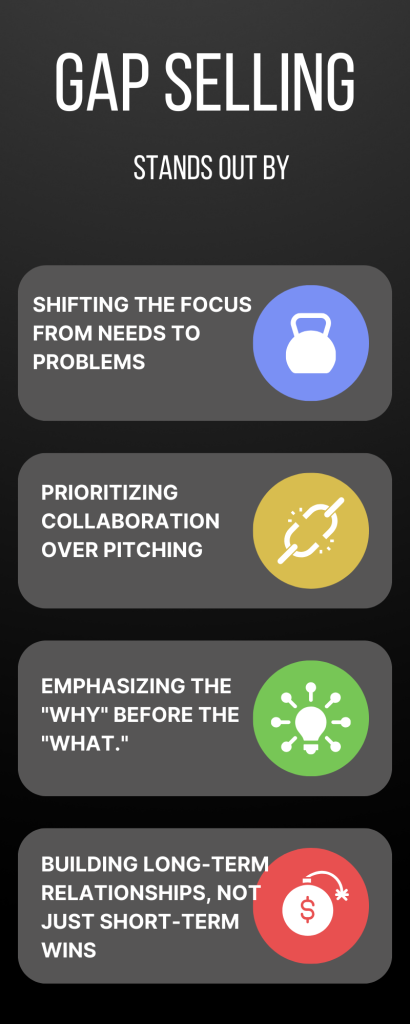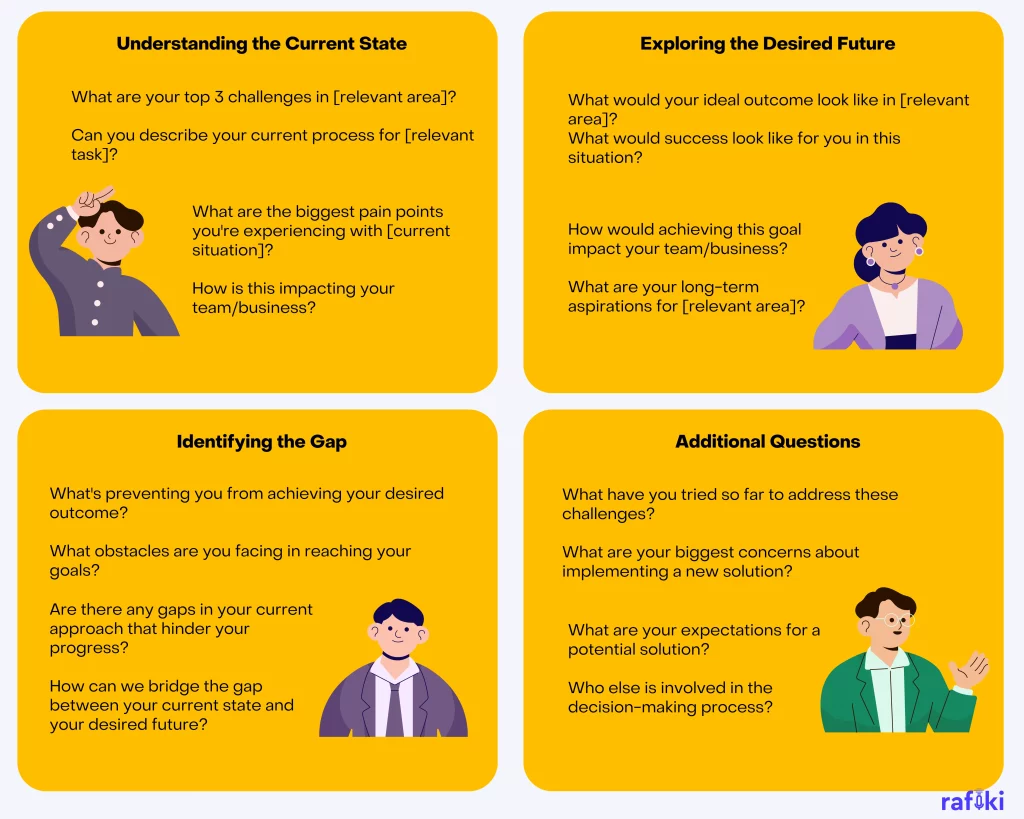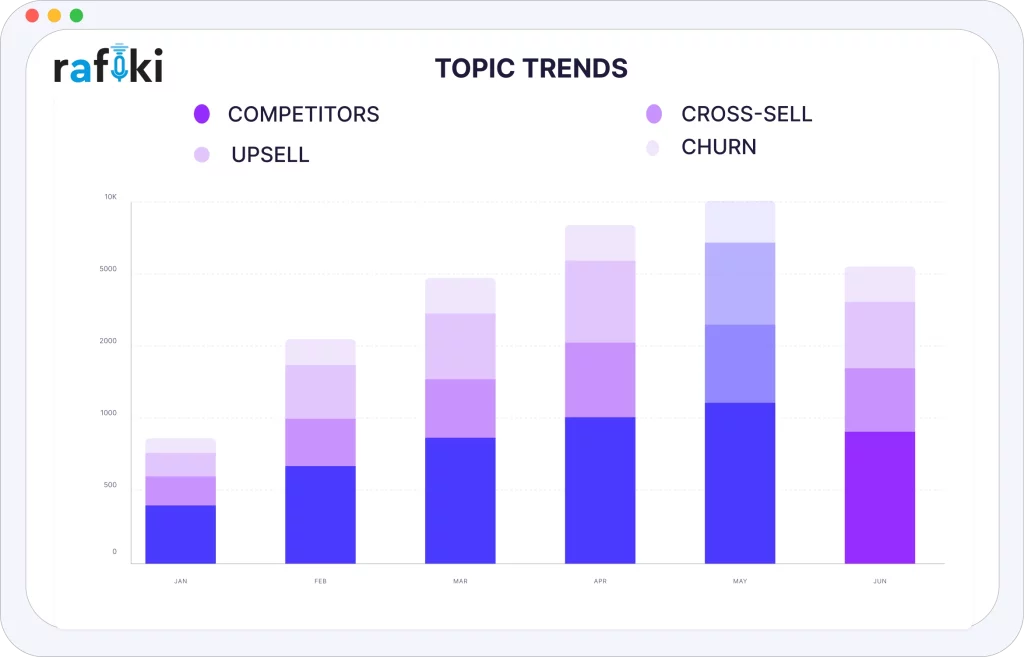Why Rafiki
Pricing


Pricing
Solutions

RevOps Leaders
Synchronize revenue generating functions

SDR Leaders
Get your team aligned and Coach your Reps 3x faster at scale

Sales Leaders
Unlock pipeline truth, drive confident forecasts

Gap Selling, as advocated by Grant Cardone, emphasizes the crucial task of identifying and bridging the gap between where a customer currently stands and where they aspire to be. This sales methodology, deeply rooted in a problem-solving approach, prompts sales professionals to engage in comprehensive discovery, pose strategic questions, and focus on offering value that effectively narrows this gap. By adopting this technique, Gap Selling aims to refine the sales process, ensuring solutions are perfectly aligned with the customer's true needs and ambitions. Integrating Analytics in Gap Selling enhances this alignment, as data-driven insights sharpen the focus on customer requirements, leading to a more efficient and successful sales strategy. This practice of continuous product discovery involves identifying and refining customer needs through ongoing, iterative research activities, thereby enhancing the alignment of offerings with business objectives and customer outcomes.
Gap Selling is a sales methodology that focuses on identifying and addressing the "gap" between the current state and the desired state of a customer or prospect. This approach emphasizes understanding the customer's specific problems, needs, and objectives to tailor a solution that bridges this gap, thereby providing real value.
Grant Cardone's Gap Selling methodology is centered around the concept of identifying and exploiting the 'gap' between a customer's current situation and where they want to be. This approach is highly customer-centric, focusing on the customer's existing challenges, goals, and the barriers preventing them from achieving these goals.
Gap Selling requires sales professionals to become deeply familiar with the customer's business or personal context, allowing them to tailor their sales pitch in a way that clearly demonstrates how their product or service can bridge the identified gap.
The core of Gap Selling lies in the identification of gaps within the customer's current state. These gaps could be in the form of unmet needs, inefficiencies in current processes, or unachieved potential benefits. Once identified, these gaps are then leveraged as pivotal points in the sales conversation. Sales professionals use these gaps to build a compelling case for their product or service, illustrating how it can effectively address the specific issues faced by the customer. This method shifts the sales dialogue from a simple product feature showcase to a more meaningful discussion about value and impact.
Traditional sales methods often emphasize the product or service, with sales pitches revolving around features, benefits, and pricing. While these elements are still important in Gap Selling, the approach differs significantly in its initial focus. Instead of leading with the product, Gap Selling starts with the customer – their current state, their desired future state, and the obstacles in between. This shift in focus from product to customer allows for a more consultative selling approach, where the sales professional acts more as a problem solver and less as a typical salesperson. This method fosters a deeper connection with the customer, as it aligns the sales process more closely with the customer's specific needs and objectives, thereby increasing the likelihood of a successful sale.
In today's competitive marketplace, the power of analytics in sales cannot be overstated. Analytics, at its core, involves extracting and interpreting data to make informed decisions. In the realm of sales, this translates to a more nuanced understanding of customer behaviors, market trends, and the overall effectiveness of sales strategies.
Imagine sailing a ship without a compass; that's sales without analytics. It guides sales teams through the murky waters of market dynamics, highlighting what works and what doesn't. By leveraging sales analytics, teams can shift from a gut-driven approach to a data-driven strategy, ensuring that every move is backed by solid evidence.
Data-driven insights are akin to having a crystal ball in sales. They allow sales teams to anticipate customer needs, tailor their approach, and deliver solutions that resonate on a personal level. This is not about bombarding customers with generic pitches but about crafting messages that hit the mark every time because they're informed by real data on customer preferences and behaviors.
For instance, analytics can reveal which products are getting the most traction, which sales scripts are converting, and even the best times to reach out to prospects. This level of precision in sales efforts can significantly enhance efficiency and effectiveness, leading to higher conversion rates and customer satisfaction.
Consider a scenario where a sales team uses analytics to predict emerging market trends. By analyzing past sales data, customer feedback, and industry news, they can identify products that are likely to see increased demand. This foresight allows them to adjust their inventory and marketing strategies proactively, staying ahead of the curve.
Another example is segmenting customers based on their behavior and preferences, identified through analytics. This segmentation enables personalized marketing efforts, where messages and offers are tailored to the specific needs and interests of different groups, resulting in higher engagement and conversion rates.
While numerous methodologies exist, Gap Selling offers a unique approach that prioritizes understanding your customer's "gap" for unparalleled results.
But what exactly sets it apart?

1. Deep Dive into the Problem, Not Just the Need:
Unlike traditional methods that focus on immediate needs, Gap Selling delves deeper. It emphasizes diagnosing the root cause of a prospect's challenges and identifying the gap between their current state and their desired future state. This in-depth understanding allows you to tailor your solution precisely to bridge the gap, not just address a temporary need.
2. Customer-Centric Collaboration, Not Product-Centric Pitching:
Gap Selling isn't about pushing your product or service. It's about collaborating with your customer to understand their specific situation and aspirations. This collaborative approach fosters trust and positions you as a trusted advisor, not just a salesperson.
3. Focus on the "Why" Before the "What":
By prioritizing the "why" behind your prospect's challenges, Gap Selling helps them clearly articulate the desired outcome they're striving for. This clarity allows you to present your solution not just as a product, but as a strategic tool that empowers them to achieve their goals.
4. Building Long-Term Relationships, Not Short-Term Wins:
Gap Selling isn't just about closing a single deal. It's about building long-term, mutually beneficial relationships with your customers. By genuinely understanding their needs and challenges, you become a trusted partner, fostering loyalty and repeat business.
By adopting this unique approach, you can transform your sales interactions, increase win rates, and build lasting customer relationships that drive sustainable success.
The Gap Selling methodology offers a unique and potentially powerful approach to sales. However, it's not a one-size-fits-all solution, and its effectiveness depends on various factors specific to your team and business. Here's a detailed breakdown to help you decide if Gap Selling is the right fit for you:
Additional Factors to Evaluate:
Carefully weigh the potential benefits and challenges of Gap Selling in the context of your specific business and sales environment. Consider conducting a pilot program with a small group of representatives. This will help assess its effectiveness and impact on key metrics before full-scale implementation.
Remember, the ideal sales methodology is not a universal solution. By understanding your unique needs and capabilities, you can make an informed decision about whether Gap Selling can empower your team to achieve sustained success.
Gap Selling thrives on asking the right questions to uncover a prospect's current state, desired future, and the gap between them.
Here are some examples of questions you can use at each stage:

Remember, these are just a starting point. Tailor your questions to the specific situation and actively listen to the prospect's responses. By effectively using Gap Selling questions, you can gain valuable insights, build trust, and position yourself as a valuable partner in achieving their desired future.
While Gap Selling offers unique advantages, it's not without its drawbacks.
Here are some key limitations to consider:
Gap Selling emphasizes in-depth customer research and analysis. This involves extensive conversations, understanding complex challenges, and uncovering the root cause of problems. This lengthy process can be challenging for teams with high sales volume or short sales cycles.
Implementing Gap Selling effectively requires significant investment in sales training. Salespeople need to develop advanced skills in active listening, questioning, problem-solving, and solution tailoring. This can be a time-consuming and resource-intensive process.
Gap Selling might not be the best fit for simple, readily understood products with standardized solutions. In such cases, a more streamlined sales approach focusing on features and benefits might be more efficient.
Over-reliance on questioning and analysis can lead to misinterpretations of the customer's situation or needs. This can result in proposing inappropriate solutions or failing to address the core problem effectively.
Gap Selling demands highly skilled and experienced salespeople who can effectively navigate complex conversations, build trust, and present customized solutions. This can be a challenge for teams with less experienced or less-trained representatives.
Customer Resistance: Some customers might be resistant to lengthy sales conversations and prefer a more direct approach.
Competition: In fast-paced environments with high competition, the time-intensive nature of Gap Selling might put you at a disadvantage.
Metrics and Measurement: Measuring the effectiveness of Gap Selling can be challenging due to its focus on long-term relationships and qualitative factors.
Gap Selling thrives on deep customer understanding gained through meaningful conversations. Conversation intelligence (CI) tools like Rafiki can be powerful allies in this process, boosting the effectiveness of your Gap Selling efforts in several ways:
Rafiki can record and transcribe your sales conversations, allowing you to review key points, identify trends, and analyze customer sentiment in detail. This facilitates a deeper understanding of customer challenges, aspirations, and the "gap" between their current state and desired future.

Using advanced NLP (Natural Language Processing), Rafiki can extract key phrases, topics, and sentiment from your conversations. This helps you identify recurring themes, pain points, and buying signals that might be missed during the conversation itself.
By analyzing conversation recordings, Rafiki can provide insights into your questioning techniques, active listening skills, and overall sales approach.
This feedback helps you identify areas for improvement. You can coach your sales team to become more effective. They'll be better at uncovering customer gaps and presenting tailored solutions.
Rafiki can identify successful conversation patterns used by top performers in your team. By sharing these best practices and ensuring consistent messaging across your sales team, you can improve the overall effectiveness of your Gap Selling approach.

While Gap Selling focuses on qualitative factors like building trust and long-term relationships, CI tools can help quantify its impact to some extent. By analyzing conversation data, you can track metrics like conversation length, customer engagement, and sentiment shifts. This can provide valuable insights into the effectiveness of your Gap Selling efforts.
Gap Selling is a powerful methodology, but it's crucial to acknowledge its limitations. Carefully evaluate your team's capabilities, target market, and sales goals before adopting this approach. By understanding the drawbacks and ensuring a good fit, you can leverage Gap Selling's strengths to achieve success in the right circumstances.
Supercharge your Gap Selling strategy
By leveraging the capabilities of conversation intelligence tools like Rafiki, you can supercharge your Gap Selling strategy.
By gaining deeper customer insights, you can empower your team. Improving sales techniques and measuring the impact of your approach are essential. These steps help your team close more deals, build stronger relationships, and achieve sustainable success.
Remember, CI tools are not a replacement for human interaction and expertise. They should be used to complement your sales efforts, not replace them. By combining the power of Gap Selling with the insights from conversation intelligence, you can create a winning formula for success in today's competitive sales landscape.